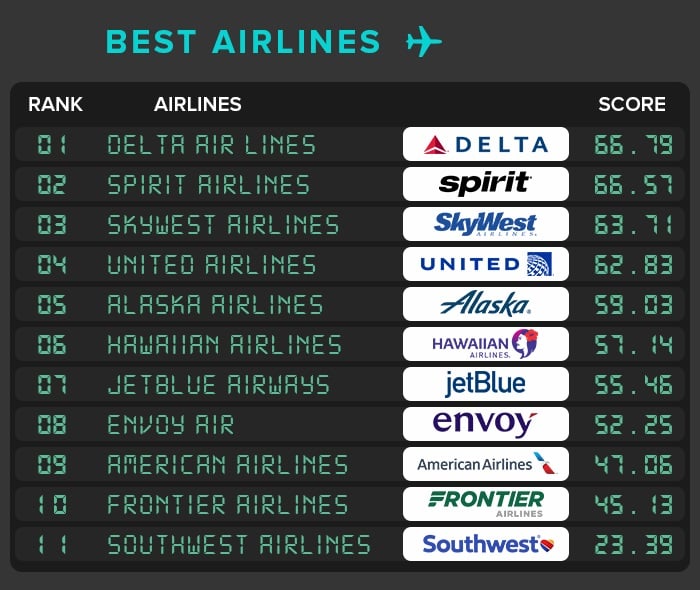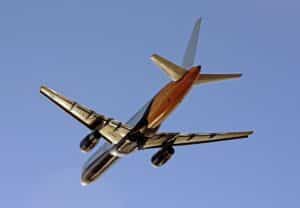by: Harry Johnson |
With airline ticket prices having gone up 25% last year, outpacing inflation, a new report that focuses not just on price but also many other aspects of the air travel experience, such as safety, delays, baggage issues, animal incidents and more, was released today.
In 2023’s Best Airlines report, airline industry experts compared the 9 largest US airlines, plus two regional carriers, across 14 important metrics. They ranged from cancellation and delay rates to baggage mishaps and in-flight comfort. Analysts also considered costs in relation to in-flight amenities.
2023’s Best Airlines
Best Airline Overall – Delta Air Lines
Most Affordable Airline – Spirit Airlines
Most Reliable Airline – Delta Air Lines
Most Comfortable Airline – JetBlue Airways
Best Airline for Pets – Delta Air Lines, SkyWest Airlines and Alaska Airlines
Safest Airline – Envoy Air

KEY FINDINGS
Most Reliable Airline: Delta Air Lines has the lowest rate of cancelations, delays, mishandled luggage and denied boardings. The next most reliable company is United Airlines.
Most Comfortable Airline: JetBlue leads the pack in terms of in-flight experience, offering free amenities such as Wi-Fi, extra legroom, and complimentary snacks and beverages. Alaska Airlines, Southwest Airlines, Delta Air Lines & American Airlines are tied for the second position for this category.
Most Affordable Airline: Spirit Airlines is the best airline for budget flyers.
Most Pet-Friendly Airline: Three airlines tied for being most pet-friendly, Delta Air Lines, Alaska Airlines and SkyWest, with no incidents.
Safest Airline: Envoy Air is the safest, with a low number of incidents and accidents per 100,000 flight operations, no fatalities and fewer than 15 people injured between 2017 and 2022. Envoy Air also has a relatively new fleet of aircrafts. The safety runner-up is Spirit Airlines.
Expert Commentary
What measures can airlines undertake in order to diminish their pilot shortage?
“One of the many barriers to entry into a professional pilot career is the cost of training. If airlines would help sponsor students through scholarships, work programs, or loan programs that would help attract students that would be ineligible to start training otherwise. One of the other ways airlines can help attract new pilots is to work with their pilot members through unions like ALPA to increase the quality of life for the pilots. Trying to recruit new pilots to be away from home for longer periods does not appeal to the current generation in training now. While pilot compensation is increasing, the overall quality of life of an airline pilot is not.”
Cody Christensen, E.D., ATP – Associate Professor, South Dakota State University
“In the short run, one effective way to reduce the impact of pilot shortage is increasing pilot salaries…Higher salaries can make the profession more attractive and incentivize pilots to stay with a particular airline. Airlines can also offer signing bonuses to attract new pilots as an incentive to join their company. This can help to attract pilots who may be considering other job offers. Airlines can improve benefits packages for pilots, such as health insurance, retirement plans, and other perks. Airlines can create schedules that allow pilots to have a better work-life balance. This can include flexible scheduling, shorter trips, and more time off. In the long run, airlines can develop training programs to help individuals become pilots. This can include scholarships, apprenticeships, and other training opportunities. Airlines can partner with flight schools to provide a steady stream of pilots. This can include financial assistance, internships, and other benefits. Airlines can invest in new technology to help reduce the workload for pilots. This can include new autopilot systems, better navigation systems, and other tools that can make flying safer and easier.”
Ahmed Abdelghany, Ph.D. – Associate Dean for Research, Embry-Riddle Aeronautical University
Which do you believe will be the main trend for the medium term in the airline industry?
“Will we see consolidation or the rise of regional players? The industry is in a constant state of change. The economic environment will dictate if there will be new players or consolidation to meet the demands of travel. I believe fuel costs will be a driving factor in the medium term. Electric aircraft is still in its infancy and will not play a role in the near or medium term.”
Jorge Guerra, Ed.D. – Director, Aviation Strategic Partnerships & Experiential Learning, Florida Memorial University
“As the number of pilots willing to work for the pay and the regional airline schedule decreases, we will see a decrease in the number of flights to small and medium-sized communities. The aircraft will continue to get bigger, which in turn will decrease the number of flights into and out of spoke communities. Consumers need to be ready for increased ticket prices and less availability in the coming years. Many military pilots and pilots trained by collegiate aviation are bypassing the regional airlines and instead moving on to National airlines such as Frontier, Sun Country, and Allegiant Air. If they are hired by regional airlines, their tenure before moving on to a major airline such as Delta, United, or UPS is much less.”
Full article: Best Airlines of 2023
Copyright: eTurboNews – Travel Industry News – about travel & tourism + news to tell



 share
share






































